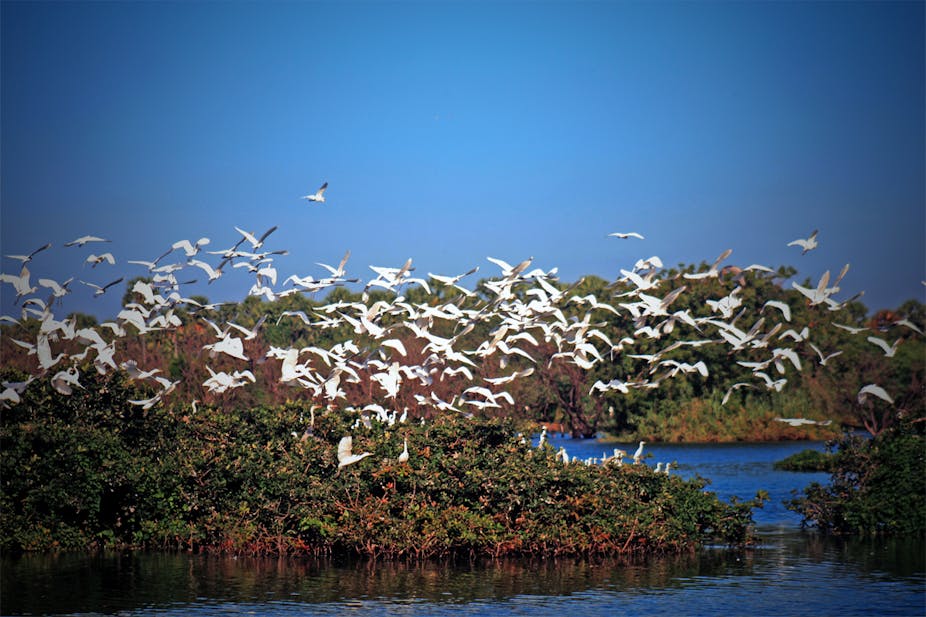Maybe it’s just a normal part of growing older and “taking the time to smell the roses”, but I’ve been finding over the past few years that I’m much more interested in birds. That hasn’t yet turned me into a “twitcher”. But as I’ve become ever more conscious of what steadily increasing human numbers and consumption patterns are doing to the livability of our small planet, I’ve realised that birds are the most readily observable biological monitoring system we have when it comes to measuring the consequences of continued habitat degradation and climate change.
This science has long been in process, with many members of national societies, such as BirdLife Australia and the US National Audubon Society, constituting a vast army of enthusiastic observers. Professional ornithologists who study bird populations in the wild could do little without them.
There’s a strong role for such volunteer organisations in this field; this is one area of human activity where someone who has absolutely no formal training in science can make a very real contribution. There’s great potential here for “citizen science” that is also greatly enhanced by the ubiquitous cameras on mobile phones and access to social media.
Though I don’t work with them directly, birds also figure in my professional life, which focuses on immunity to infection, particularly influenza. None of us can be unaware of the terrible bird flu, but few will be familiar with the back-story of how such viruses reach the human population.
In nature, flu viruses are basically infections of water birds that occasionally jump the species barrier to establish in seals, horses, dogs, pigs and humans. Then, there are other pathogens, such as West Nile virus and Murray Valley encephalitis virus, from which humans suffer occasional collateral involvement, and even death, as a consequence of being bitten by a mosquito that happens to have fed on an infected bird.

But for birds themselves, such viruses can pose a much greater threat. The introduction of West Nile virus into the United States more than a decade ago, for instance, led to massive losses in crow, jay and magpie populations.
Epidemiologists park flocks of “sentinel chickens” round the countryside, for regular sampling to monitor the extent of West Nile virus and Murray Valley encephalitis spread. Like us, when bitten by a virus-carrying mosquito, birds make antibodies that circulate thereafter, providing “footprints” of the infection that are readily detected by testing a blood sample.
Birds also have their own infectious disease problems that can reflect our behaviour, such as migration and smuggling, but do not directly affect us. The inadvertent European introduction of the mosquito vector for avian malaria, for example, is considered to have wiped out more than 40% of native Hawaiian species over the past 150 years or so.
Ronald Ross, who was awarded the 1902 Nobel Prize for establishing the life cycle of malaria, did his key experiments in birds. Studies of a chicken pathogen, Rous Sarcoma virus, have illuminated our understanding of human cancer, in experiments that were recognized by three Nobel Prizes.
In the main, bird enthusiasts don’t know these stories and are intrigued by them.
Though most of my career has been in basic medical research, I trained initially as a vet and am frequently asked to visit veterinary schools. One such trip was to Ondersterpoort, near Pretoria in South Africa, where I heard how a familiar drug that works well in people has, when used to relieve inflammatory conditions in cattle that sometimes die, wiped out some 95% of Indian Gyps vultures. The impact on this population of carrion eaters has, in turn, led to greatly increased numbers of wild dogs, with the consequence that many more people are contracting rabies.

There are also well-documented cases (in Australia and elsewhere) of massive bird “wrecks” that provided an early warning of environmental lead and mercury pollution.
From oil drilling, transport, and the positioning of skyscrapers, power lines and houses, to the inappropriate disposal of degradable plastic bags, and hunting and fishing with lead shot and sinkers, human inattention and carelessness has major deleterious consequences for bird populations.
Early indications of the effects of climate change are being seen in modified migration patterns and in the operation of Bergmann’s rule (heat stress leads to decreased body size) for some avian species, while the consequences of injudicious commercial development in sensitive habitats and effects on food availability (over-fishing) are increasingly obvious.
Apart from their obvious aesthetic value, birds control insects, distribute seeds and pollens, clean up the environment and move nutrients from the oceans to the land. They are our not-so-distant relatives and deserve our regard. And it’s time to give them more consideration, because as the birds go, so ultimately will we.
Peter Doherty’s latest book, Sentinel Chickens: what birds tell us about our health and the world is being launched today by Melbourne University Publishing.

